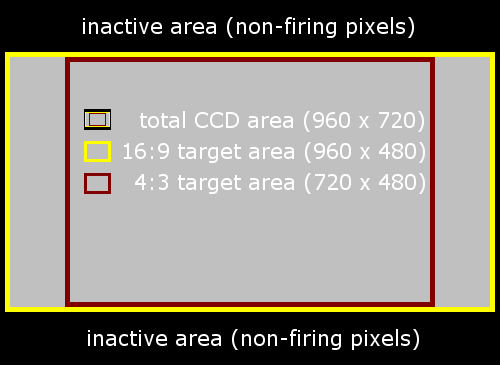The XL2 Watchdog
Introduction
|
> top of page < |
Canon XL2 CCD Block Overview
by Chris Hurd
Some readers may wonder how the XL2 forms a native 16:9 image with one-third inch CCD's, when all such CCD's available on the market today are made in a standard 4:3 aspect ratio (only two-thirds inch CCD's in some very expensive high-end professional video cameras are made in a 16:9 aspect ratio). The answer lies in how Canon chose to utilize the available pixel real estate on each of the three one-third inch chips in the XL2. In the North American and Japanese NTSC version of the XL2, each of these 4:3-shaped CCD's contains a total of 680,000 pixels. Within this pixel array lies the 16:9 target area, composed of 460,800 pixels (for an image size of 960 x 480). All pixels above and below this rectangular widescreen area are "turned off," that is, they're inactive, neither receiving incoming light nor generating a signal. Only those pixels which lie within the 16:9 target area are actively firing. For standard 4:3 aspect ratio video recording, a smaller target area of 345,600 pixels is used (for an image size of 720 x 480). The graphic below illustrates this concept.
Note that the target areas for both the widescreen 16:9 and standard 4:3 aspect ratios are smaller overall than the actual CCD area itself. There are two primary concepts to understand with regard to the size of the XL2's smaller target areas. First, although these areas are physically smaller than the previous XL1 and XL1S which utilized the entire one-third inch sensor, the XL2 is providing more pixels and therefore higher image resolution within its target area compared to the XL1 and XL1S (345,600 pixels in the XL2 compared to 250,000 pixels for the XL1 and XL1S in standard 4:3 mode for NTSC models). Second, because these target areas are smaller in the XL2 than they were in the XL1 and XL1S, there is a slight magnification in the field of view for all XL-mount lenses. The multiplication factor for using an XL lens on the XL2 is 1.105 in the widescreen 16:9 aspect ratio and 1.35 in the standard 4:3 aspect ratio. Basically this means that all XL lenses are just slightly more telephoto on the XL2 than they are on the XL1 or XL1S.
For the PAL system XL2 sold in Europe, Australia and the U.K., the CCD's are the same physical size, but the pixel counts are different. The total area of each CCD is composed of 800,000 pixels. The 16:9 target area is 960 x 576 (550,000 pixels) and the 4:3 area is 720 x 576 (410,000 pixels). For those who may be unfamiliar with DV camcorders recording in the PAL system, be advised that it's still a DV25 format, with the same data rate as a DV camcorder using the NTSC system, at 25 megabits per second. Therefore, the higher resolution of PAL video is offset by a slower frame rate: on the PAL XL2, you have a choice of 50i (fifty interlaced fields per second) or 25p (twentyfive progressive frames per second). Whether you shoot with an NTSC or PAL system camera, the data written to the DV cassette is the same, at 25mbps.
The chart below offers some comparative CCD data for a variety of current and popular 3-CCD DV camcorders (these are NTSC versions), including the implementation of Pixel Shift (a Panasonic technology), and the Digital Signal Processor bit depth.
Comparison of CCD Specifications of some 3-CCD DV Camcorders CCD
sizepixel count pixel shift DSP total effective Canon XL2 1/3 680,000 460,800* horizontal 12-bit Canon XL1 / XL1S 1/3 270,000 250,000 horiz & vert 8-bit Panasonic DVX100A 1/3 410,000 380,000 horizontal 12-bit Sony VX2100 1/3 380,000 340,000 N/A ? Canon GL2 1/4 410,000 380,000 horiz & vert 8-bit Panasonic DVC30 1/4 410,000 380,000 horizontal 12-bit Sony TRV950 1/4.7 1,070,000 690,000 N/A 14-bit Panasonic PVGS200 1/6 800,000 440,000 N/A ? * XL2 in 16:9 mode only (345,600 effective pixels in 4:3 mode) Prior to the announcement of the XL2, there was some speculation regarding Canon's choice of image sensor for the forthcoming camera. Some people wondered if the XL2 would contain CMOS (Complementary Metal-Oxide Semiconductor) chips instead of CCD (Charged Coupled Device) image sensors. Canon is not in the CCD business (these image sensors are outsourced from other manufacturers), but they do make their own CMOS sensors for their high-end digital still photography cameras such as the Canon EOS-1DS. The Canon CMOS imagers are optimized for photography, not video; these chips create extremely large images, which is what they're designed to do. However, they are not designed for the continuous rate of thirty frames per second which is required for full-motion video. For instance, the EOS-1DS can manage a ten-frame burst of high-res images at a rate of several frames per second, but the Canon CMOS gates cannot be cleared fast enough for sustained usage in a video environment demanding 30fps for very long durations. In summary it is perhaps easier to say that Canon CMOS image sensors simply aren't designed for video applications.
Back to the XL2 Articles Menu.
Thrown together by Chris Hurd.
Please direct questions to the DV Info Net Community Forums.
Where to Buy: These dealers are authorized DV Info Net sponsors... | |||
|
|
|
|
|
|
|
|
Please support this site by making your purchases through them. Thanks! | |||
©1998-2008 DV Info Net
The Digital Video Information Network
San Marcos, Texas
Try not! Do... or do not. There is no try.
